The Aircraft Is Tasked with Ballistic Missile Submarine Communications.
A U.S. Navy E-6B Mercury “Doomsday Plane” made a precautionary landing on Tuesday, March 5, 2019 at Tulsa International Airport at approximately 3:00 PM local. The crew were seen to evacuate the aircraft using the emergency slides. At least one crew member appeared to be covering his face, possibly reacting to smoke in the aircraft.
According to the U.S. Navy, the aircrew experienced fumes in the aircraft due to a faulty water separator. Unlike what was initially reported, there was no fire alarm on board.
The precautionary landing was due to fumes in the aircraft due to a faulty water separator. No fire or alarm.
— flynavy (@flynavy) March 7, 2019
The incident is noteworthy because of the E-6B Mercury’s role in strategic defense. The aircraft is operated by Strategic Communications Wing One (STRATCOMWING ONE).

This is what our Editor David Cenciotti wrote about this aircraft in the past:
The U.S. Navy has a total fleet of sixteen E-6B Mercury (TACAMO – “TAke Charge And Move Out”) that play an extremely important role for U.S. National Security: they are used to relay instructions to the fleet ballistic missile submarines in case of nuclear war but also act as back ups of the four E-4Bs NAOC (National Alternate Operations Center), working as ABNCP (Airborne Command Post) platforms (hence “Doomsday Plane“).
They are often trackable online, while performing various critical missions: the so-called Looking Glass mission (mirroring the ground-based C3 center at Offutt AFB and relaying orders); talking to submarines trailing a 26,000 ft wire antenna; launching commands to ICBMs (InterContinental Ballistic Missiles) via Airborne Launch Control System, and performing C3 (Command Control Communication) operations to forces operating in theater or to the U.S. strategic bombers flying Global Strike missions.
The Mercury is capable to communicate on virtually every radio frequency band, on commercial satellites and on the Internet, using also a secure VOIP system. This aircraft usually operates flying orbits/circles while trailing their antennas or to exploit a particular geostationary satellite for radio comms.
[…]
E-6s regularly support B-2 bombers involved in long-range missions, acting as “Skymaster” (USSTRATCOM airborne command post and communication relay).
Therefore, the E-6B acts as an emergency communications platform to issue or relay launch orders to nuclear-powered ballistic missile submarines on active patrol around the world. Should ground-based nuclear ballistic missile command and control facilities be destroyed in a first-strike on the U.S., the E-6B Mercury aircraft could issue launch directives from flight. E-6B Mercury aircraft can also direct other strategic nuclear strike assets in the event of a crisis when ground-based strategic command and control assets are compromised.
It is unknown if the aircraft involved in the emergency landing was from VQ-3 or VQ-4, flying an active mission as part of the ongoing strategic nuclear deterrent force or if this aircraft was attached to VQ-7, the training unit that supplies the two operational units.
Notable features of this E-6B Mercury include a five-mile long wire antennae that is trailed at a near vertical angle behind the plane in flight to communicate with submerged nuclear powered fleet ballistic missile submarines.
Media outlets reported that no crew members were transported to medical facilities following the incident. No further information about the emergency landing incident has been reported.










